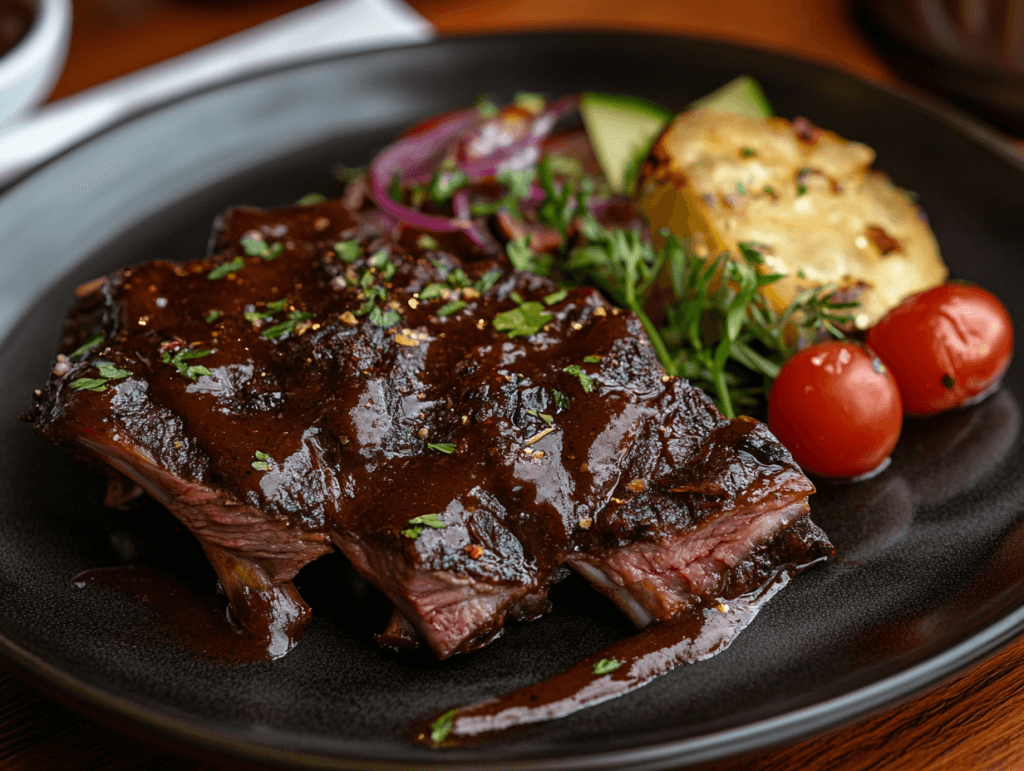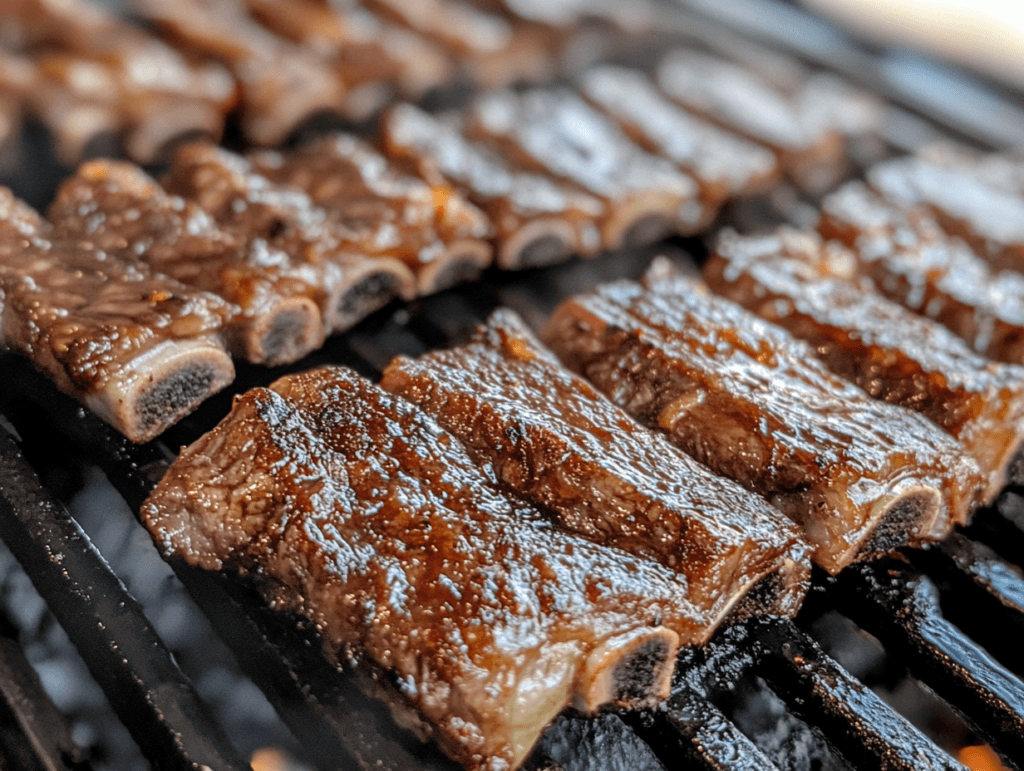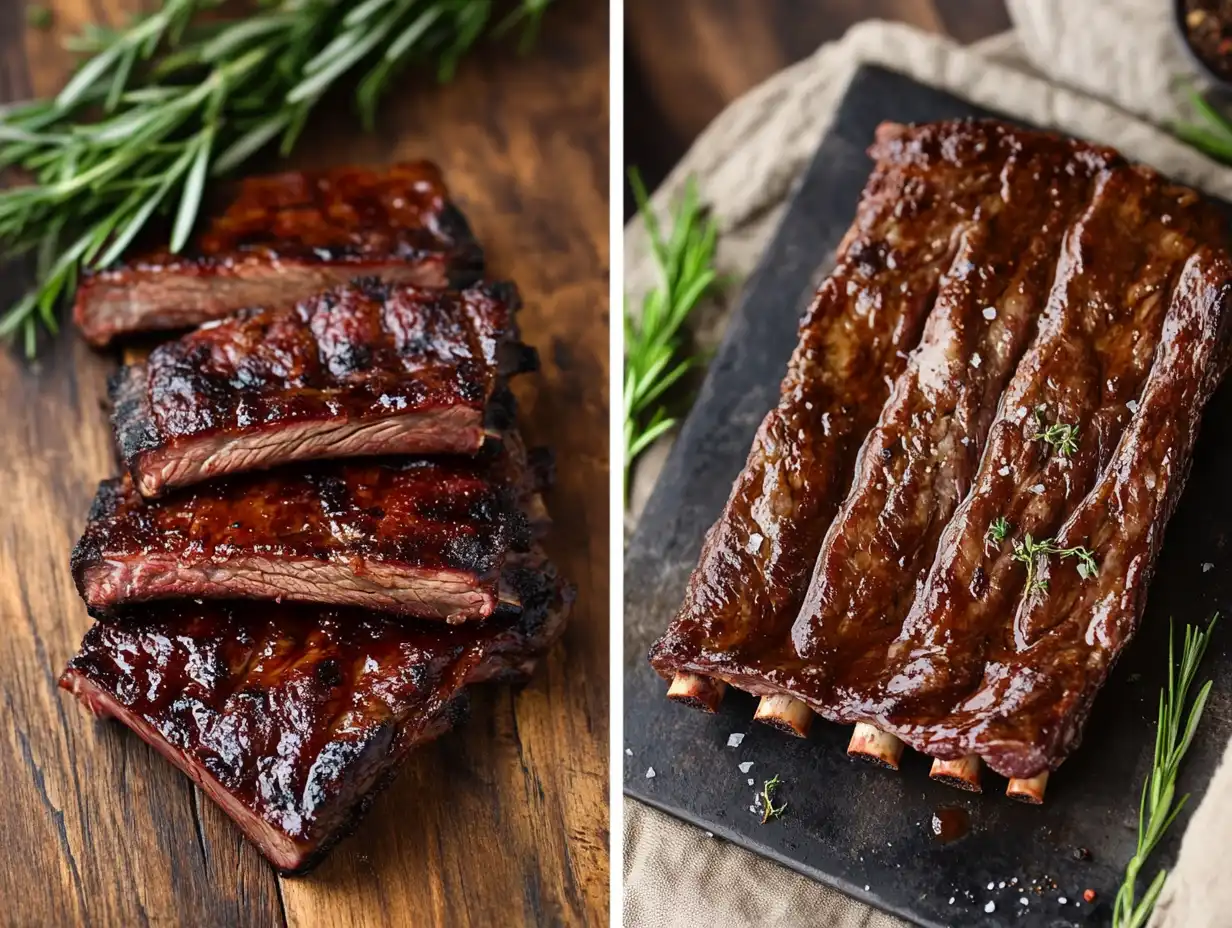Are boneless beef ribs the same as short ribs ?Beef ribs hold a special place in many cuisines because of their rich flavor, versatility, and ability to transform any meal into a hearty feast. However, many people often confuse boneless beef ribs with short ribs, leading to questions about whether they are the same cut or if they taste and cook the same way. Does Short Rib Get More Tender the Longer It Cooks? can help you understand how cooking time influences the tenderness of short ribs.
In this article, we will clarify the distinctions between these two popular beef cuts. We will explain where each cut comes from on the cow, describe their textures, outline their cooking methods, and discuss when you can substitute one for the other. By the end, you will have all the details you need to select the perfect cut for your next recipe.
Table of Contents
Understanding Boneless Beef Ribs
What Are Boneless Beef Ribs?
Boneless beef ribs, despite their name, aren’t technically ribs at all. They are often cut from the chuck or rib primal area of the cow, particularly near the shoulder. The term “boneless ribs” is a bit of a marketing strategy designed to appeal to consumers who enjoy the rich, beefy flavor associated with ribs but prefer the convenience of a boneless cut.explore this Easy Boneless Beef Short Ribs Recipe.
These cuts are typically rectangular or strip-like, resembling the appearance of traditional ribs once cooked. They boast a robust flavor and a slightly firm texture that makes them ideal for slow-cooking methods like braising or smoking. However, they lack the signature marbling and connective tissue found in bone-in ribs, which can influence both flavor and tenderness.
Cuts Used for Boneless Beef Ribs
Boneless beef ribs are most commonly sourced from the following areas:
- Chuck Eye Roll: This is the continuation of the ribeye muscle into the shoulder, offering a balance of meatiness and fat.
- Plate or Rib Primal: Occasionally, boneless beef ribs may come from the rib primal, but these cuts are typically thinner and leaner.
These cuts differ significantly from traditional short ribs, which are taken from the lower ribcage. Their origin also influences the cooking characteristics of boneless beef ribs, making them less fatty but equally flavorful when prepared correctly.
How Boneless Beef Ribs Are Prepared
The preparation of boneless beef ribs depends largely on the cooking method and desired outcome. Popular preparation methods include:
- Slow Braising: Cooking in liquid over a long period enhances tenderness and infuses the beef with flavors from the broth or sauce.
- Grilling or Smoking: Exposing the meat to high heat or smoke creates a caramelized exterior while locking in the juices.
- Pan-Searing and Oven Finishing: This hybrid method starts with a quick sear for flavor and finishes in the oven for a consistent cook.
Unlike short ribs, which benefit significantly from their bone content during cooking, boneless beef ribs rely on seasoning and marinating to build their flavor profile.
Understanding Short Ribs
What Are Short Ribs?
Short ribs come from the lower ribcage of the cow, specifically the plate, chuck, or brisket sections. They earn their name from their shorter length compared to the full rib bones typically seen in traditional ribs. Butchers offer short ribs as either bone-in or boneless cuts, with bone-in short ribs being more popular for their superior flavor and presentation.
Characterized by their rich marbling and connective tissue, short ribs are incredibly tender and flavorful when cooked properly. The fat content and the presence of bone contribute to the depth of flavor, especially when slow-cooked or braised, making short ribs a favorite in cuisines like Korean barbecue, American comfort food, and French stews.If you’re wondering why short ribs often feel tough, read more in Why Boneless Short Ribs Are Tough.
Bone-In vs. Boneless Short Ribs
Short ribs come in two main types:
- Bone-In Short Ribs: This traditional variety is highly valued for delivering deep, beefy flavors during cooking. The bone conducts heat and enhances the flavor, contributing to a rich and savory dish.
- Boneless Short Ribs: These are created by removing the bone and excess connective tissue, offering a more versatile and easier-to-handle cut. While slightly leaner than bone-in short ribs, they still boast plenty of marbling.
Although boneless short ribs are sometimes confused with boneless beef ribs, they differ greatly in both flavor and texture. The marbling and connective tissue in short ribs make them much more tender.
How Short Ribs Are Typically Cooked
Short ribs shine in cooking methods that break down their connective tissue over time, transforming the meat into tender, flavorful perfection. For the best preparation techniques, check out Preferred Cooking Method for Boneless Short Ribs.
Popular techniques include:
- Braising: Sear the short ribs before simmering them in liquids like red wine, beef broth, or soy-based sauces for several hours. This process creates meat so tender it falls off the bone.
- Smoking: Slow-smoking short ribs infuses them with a deep, smoky flavor, enhancing their natural richness.
- Grilling (Korean BBQ Style): In Korean cuisine, short ribs are sliced thin across the bone (known as “kalbi”), marinated in a sweet and savory sauce, and quickly grilled to perfection.
These methods showcase the versatility of short ribs and explain why they are a favorite for hearty, flavor-packed meals.

Key Differences Between Boneless Beef Ribs and Short Ribs
Cut Origin
The primary difference between boneless beef ribs and short ribs lies in their origin on the cow.
- Boneless Beef Ribs: Typically cut from the chuck or rib primal areas, boneless beef ribs are not true ribs but rather a portion of the shoulder or ribeye muscle. This cut lacks the bone and is more akin to a steak-like strip.
- Short Ribs: Sourced from the plate, chuck, or brisket sections, short ribs are a true rib cut. They include a portion of the rib bone and the meat attached to it, giving them a distinctive structure and flavor profile.
This difference in origin affects not only the taste and texture of the meat but also how it responds to various cooking methods.
Texture and Marbling
The texture and fat distribution of each cut are also markedly different:
- Boneless Beef Ribs: These cuts are leaner with less connective tissue and marbling. While still flavorful, they tend to be slightly firmer and require marinating or tenderizing for the best results.
- Short Ribs: Known for their rich marbling and ample connective tissue, short ribs become incredibly tender and juicy when cooked slowly. The bone further enhances the overall flavor, making short ribs a luxurious choice for slow-cooked dishes.
Cooking Methods
The differences in fat content and structure dictate the ideal cooking methods for each cut:
- Boneless Beef Ribs: These are best suited for grilling, smoking, or quick searing, as they benefit from high-heat methods that add char and flavor without requiring extensive cooking times.
- Short Ribs: Perfect for low-and-slow methods like braising or smoking, short ribs need longer cooking times to break down their connective tissue and release their full flavor potential.
Flavor Profile
Short ribs and boneless beef ribs also differ in flavor. The presence of the bone and higher fat content in short ribs results in a richer, more unctuous flavor, while boneless beef ribs have a robust but slightly milder taste. These differences are crucial when deciding which cut to use based on the dish you’re preparing.
Are Boneless Beef Ribs a Substitute for Short Ribs?
When Can Boneless Beef Ribs Be Substituted?
Boneless beef ribs can occasionally serve as a substitute for short ribs, depending on the dish and desired outcome. They work well in recipes where the focus is on tender, flavorful beef rather than the richness imparted by the bone. For example:
- Grilled Dishes: Boneless beef ribs can shine as a substitute in barbecue recipes where a smoky, caramelized exterior is the main goal.
- Stir-Fries: Their leaner texture makes them suitable for quick-cooking methods like stir-frying, where marinating can enhance tenderness.
- Sandwich Fillings: When shredded or thinly sliced, boneless beef ribs can mimic the texture and taste of slow-cooked short ribs in hearty sandwiches.
However, adjustments in cooking time and preparation may be necessary to achieve similar results, as boneless beef ribs cook faster and lack the connective tissue that adds depth to long-cooked dishes.
When Should Short Ribs Be Used?
Short ribs are best used in recipes that rely on their rich, fatty flavor and the benefits of bone-in cooking. These include:

- Braising: Dishes like braised short ribs in red wine or Asian-style soy sauce braises are unparalleled in flavor and texture when made with short ribs.
- Stews and Soups: Short ribs add a depth of flavor that’s difficult to replicate with boneless beef ribs, making them ideal for hearty stews.
- Bone-In Presentations: For visually appealing dishes or recipes where the bone enhances the experience (like slow-roasted platters), short ribs are irreplaceable.
Flavor Considerations
The differences in flavor between boneless beef ribs and short ribs stem from their fat content and cooking characteristics:
- Boneless Beef Ribs: These offer a slightly milder flavor, relying heavily on marinades, rubs, or sauces to deliver bold taste.
- Short Ribs: The bone and fat provide an inherent richness, making them a star ingredient in recipes that emphasize depth and complexity.
While boneless beef ribs can replicate the texture of shredded or pulled beef found in some short rib dishes, they lack the robust umami that short ribs naturally bring to the table. Knowing when to use each cut ensures the best culinary results.
FAQs About Boneless Beef Ribs and Short Ribs
Why Are Boneless Beef Ribs More Affordable?
Boneless beef ribs usually cost less than short ribs because butchers cut them from parts of the cow, such as the chuck or rib primal, that don’t have as high a demand for premium cuts. These sections provide multiple cuts, which makes boneless beef ribs more economical to produce. In contrast, short ribs come from specific areas valued for their marbling and flavor, which drives up their price.
Do Boneless Beef Ribs Take Less Time to Cook?
Yes, boneless beef ribs generally require less time to cook compared to short ribs. Because they lack the dense connective tissue and bone structure of short ribs, boneless beef ribs tenderize more quickly. For example:
- Boneless Beef Ribs: Often take 1-2 hours in a slow-cooking method like braising.
- Short Ribs: Can require 3-5 hours or more to fully break down the connective tissue and render the fat.
However, careful monitoring is necessary with boneless beef ribs to avoid overcooking and drying out the meat.
Are Short Ribs Always More Flavorful?
While short ribs are often considered more flavorful due to their marbling and bone content, the choice of seasoning, cooking method, and preparation can make boneless beef ribs equally delicious. When properly marinated or cooked with a flavorful sauce, boneless beef ribs can hold their own in terms of taste.
Can Boneless Beef Ribs and Short Ribs Be Cooked the Same Way?
In certain situations, you can cook boneless beef ribs and short ribs using similar techniques, but some adjustments are required:
- Slow-Cooking: Both cuts work well for slow cooking, though boneless beef ribs tend to cook faster and may require less time to reach tenderness.
- Grilling: Short ribs, particularly Korean-style thinly sliced cuts, excel on the grill due to their quick cooking and caramelized flavors. Boneless beef ribs can also be grilled but require a gentler approach to avoid overcooking and drying out.
By tailoring the cooking method to each cut, you can achieve the best results for your dish.
What’s the Best Way to Enhance Flavor for Each Cut?
- Boneless Beef Ribs: Marinades, spice rubs, and sauces are key to building flavor.
- Short Ribs: Slow-cooking techniques that allow the fat to render and the bone to impart flavor are ideal.
Which Is Better for Meal Prep or Freezing?
Boneless beef ribs are often better for meal prep and freezing because:
- They are easier to portion into uniform sizes.
- They freeze well without the risk of the bone affecting the texture over time.
Short ribs, while excellent when cooked fresh, can lose some of their texture and flavor complexity when reheated after freezing.
Conclusion
When it comes to deciding between boneless beef ribs and short ribs, understanding their differences can help you make the best choice for your culinary needs. While both cuts deliver rich, beefy flavors, their distinct characteristics make them better suited for specific dishes and cooking methods.
- Boneless Beef Ribs: Leaner and more versatile, these are ideal for faster cooking methods like grilling and stir-frying. They work well in dishes where convenience and ease of preparation are priorities. However, they may require marinades or seasonings to match the depth of flavor found in short ribs.
- Short Ribs: With their high fat content, marbling, and bone-in structure, short ribs excel in slow-cooked recipes that require tenderness and rich flavor. They are the go-to choice for braising, smoking, or soups that call for a luxurious beef base.
Both cuts make excellent additions to your cooking repertoire when used appropriately. By evaluating the desired texture, cooking time, and flavor profile, you can determine which cut suits your next dish best. Whether you opt for boneless beef ribs or short ribs, you’ll create a satisfying and flavorful meal.

